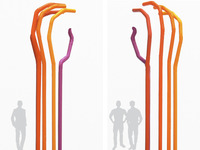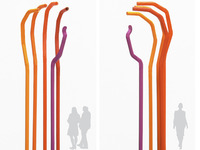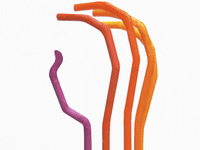

































































































In mid-March 2020 a competition entry was submitted for the Chamber of Manual Trades in Garbsen near Hanover. The proposal with the title “Kopfhand” (Headhand) is a monumental signet for the outdoor area in front of the teaching building. This is a place of education for the following trades: bricklayers and concrete builders, sanitary, heating and air-conditioning technicians, joiners, carpenters, glaziers, painters and decorators, bodywork builders and electricians, gold- and silversmiths.
The entrance to the workshops gains a signet, a conspicuous sign marking this entrance. This is why the object Kopfhand has the character of a signet. It conveys a multi-layered message.
Kopfhand conveys growth and development. Five round rods grow vertically from the ground and form an image at a height that can be seen from a distance.
Kopfhand conveys diversity: the diversity of trades and courses of learning, as well as individual and personal diversity. The round rods differ from one another in their colour.
Kopfhand conveys the hand. The five rods form a linear drawing, with the association of a grasping hand in abstract reduction. The hand has always been the common denominator of manual trades.
Kopfhand conveys the head. In its character as an image, the linear drawing has the openness to suggest the hand and the head at the same time. The head represents knowledge, thought, decision.
Kopfhand conveys the link between hand and head in the sense of merging. Expertise in a manual trade arises only when the hand and head complement each other. Manual activity arises only when the hand and head are congruent.
Kopfhand conveys modernity. Its formal language creates a counterpoint to the romantic tradition of the apprentice.
Kopfhand is an object that speaks clearly.
































































































































































































